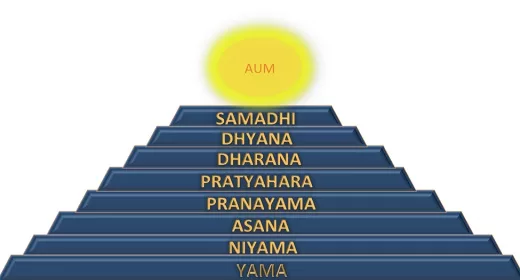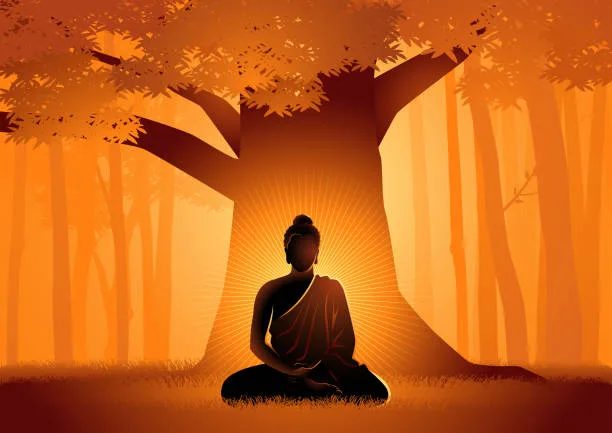Nirvikalpa Samadhi has been expounded and elucidated via diverse interpretations by various religious institutions and spiritual traditions, each rooted in distinct lineages of sages and belief systems. This blog is intended for individuals who possess a spiritual inclination or engage in the pursuit of advanced spirituality with the potential to achieve supernatural abilities and enlightenment.
However, amongst the competitive pursuit of what is commonly referred to as the revered state of enlightenment, a select few among you are proceeding with caution along the journey to obtain the ultimate state of bliss: In this blog post, we present comprehensive information regarding the Nirvikalpa Samadhi and its associated aspects. Let us proceed directly to the topic at hand.
Ramana Maharshi defined samadhi as a state of heightened spiritual consciousness characterized by an uninterrupted and ongoing experience of existence, sustenance, and consciousness. The state of focused concentration can be broadly characterized by terms such as pure joy, calm, and ecstasy. This condition should not be misconstrued as a passive state like that of a mummy or fossil, as some individuals who are distant from matters of spirituality may believe. This refers to the perception of reality as a whole, characterized by a state of comprehensive cohesion and wholeness.
Yoga is characterized by the cessation of the gap between the viewer and the visible in the state of Samadhi. According to Vedic knowledge, the state of awareness being referred to is deemed ineffable, necessitating personal experience of samadhi in order to comprehend it. One distinguishing factor between sleep and yoga samadhi is the outcome experienced upon emerging from the latter state when the individual attains transcendental wisdom.
The diverse samadhis followed
Both savikalpa and nirvikalpa samadhi are transient conditions, subsequent to which ordinary human consciousness is reinstated. In the realm of spiritual practice, it is widely acknowledged that enduring or permanent states of samadhi, such as sahaja or dharmamegha samadhi, are the ones that enable individuals to interact with the material world while being grounded in an elevated state of consciousness. Only a small number of people who have attained mastery in the field of spirituality can achieve these states of being because they are so advanced.
Nirvikalpa Samadhi represents a further stage in the attainment of the ultimate state of Samadhi. The samadhis are basically classified as,
- Savikalpa Samadhi refers to a state of consciousness characterized by the transcendence of mental activity or the attainment of access to concentration.
- Nirvikalpa Samadhi refers to an elevated level of consciousness characterized by the absence of any mental fluctuations, wherein only pure awareness persists.
- The state of Dharmamega Samadhi entails the complete dissolution of the desire to comprehend and accept the divine.
There exists a scholarly discourse surrounding the notion of Sahaja Samadhi as the pinnacle of spiritual attainment, with certain proponents positing its placement in the intermediary space between Nirvikalpa and Dharmamega. The assertion remains unverified, as individuals or entities capable of providing substantiation have not yet attained the requisite degree of spiritual ascendancy.
Swami Vivekananda, a practitioner who transcended the condition of Savikalpa Samadhi and attained Nirvikalpa Samadhi, articulated his encounter as a liberated physical body and mind disengaged from external engagements, resulting in the dissolution of his inner self and the acquisition of boundless wisdom.

Defining Nirvikalpa Samadhi
The term “Nirvikalpa Samadhi” refers to a state of deep meditative absorption in which the practitioner experiences a complete cessation of mental activity and a profound sense of oneness with the object of meditation.
Nirvikalpa samadhi is the subsequent phase of samadhi, denoting a state of profound concentration and happiness achieved via meditation. According to Patanjali’s Yoga Sutras, Samadhi is the culminating stage of the yogic journey, serving as the eighth and ultimate step.
The term in question originates from many Sanskrit roots, namely sam, which conveys the notions of “together” or “completely,” a, which signifies “toward,” and she, denoting “put.”
The translations of the term in question exhibit variation, with meanings encompassing concepts such as “bliss,” “liberation,” and “enlightenment.” The term “Nirvikalpa” can be derived from the Sanskrit language, where it signifies the absence of wavering. This linguistic translation emphasizes the characteristics of this particular state of samadhi, which are characterized by their enduring and unwavering nature.
The attainment of Nirvikalpa Samadhi is limited to practitioners who have reached an advanced level of proficiency, having successfully traversed preceding levels such as Dharana, which involves focused attention, and Dhyana, which entails sustained meditation.
It has been observed that individuals who have attained spiritual mastery may sustain this condition for extended periods of time, ranging from hours to days. It is widely held that prolonged immersion in nirvikalpa samadhi, lasting between 18 and 21 days, facilitates the attainment of elevated stages of samadhi, wherein consciousness potentially transcends the confines of the physical body on a permanent basis.
The concept of Nirvikalpa Samadhi
The concept of Samadhi bears resemblance to the notion of Divine Consciousness as expounded in the Shankara Tradition. It denotes a profound state of affection for the world and its constituents, wherein one acknowledges the presence of Divinity in all aspects of existence. The object is transitioning towards a celestial domain. Ritambhara Pragya is an experiential state in which an individual’s thoughts undergo spontaneous manifestation into tangible reality.
The concept of time encompasses the integration of the past and future, resulting in a perpetual state of the present. The current state of affairs is characterized by a sense of immediacy and contemporaneity. All necessary components are present within this context. The concepts of time and space have been surpassed. The feeling of exalted happiness may endure for a varying duration, ranging from a few hours to many days.
Nirvikalpa samadhi is widely acknowledged within the realm of consciousness studies as a profoundly elevated condition, occupying the second stage of samadhi. In the religious traditions of Hinduism and Buddhism, the state of samadhi holds a significant position as the highest form of spiritual and intellectual engagement.
Moreover, it is considered a necessary prerequisite for achieving moksha, which denotes liberation from the perpetual cycle of death and rebirth. Within the context of yoga, Samadhi is widely regarded as the ultimate stage of Patanjali’s comprehensive eightfold path. It is a profound state wherein the consciousness of the individual merges harmoniously with the universal consciousness.

While there may be variations among schools on the precise number of degrees of samadhi, there is a consensus that the stage preceding nirvikalpa samadhi is known as savikalpa samadhi. During this stage, practitioners experience meditative absorption and undergo a transformation in their perception of time and space.
In the state of savikalpa samadhi, cognitive processes continue to persist, albeit without exerting any influence on the practitioner. Conversely, in Nirvikalpa Samadhi, the mental faculties assimilate with the individual’s self. Consequently, this mental state represents complete immersion, when the ability to discern any differentiation between the one who possesses knowledge, the process of acquiring knowledge, and the entity being understood becomes unattainable.
Nirvikalpa Samadhi And eight limbs, As outlined in Patanjali’s Yoga Sutras
Nirvikalpa samadhi is a state of profound meditative absorption when the dissolution of the ego and samskaras, which are impressions stored in the mind or emotions, results in the emergence of pure awareness as the sole remaining entity. The concept under consideration pertains to a condition characterized by a harmonious union with the Divine, wherein the particular self, known as Atman, and the universal awareness, referred to as Brahman, converge. The state in question has been characterized as a state of unity, boundless euphoria, or genuine rapture. However, individuals who have endeavored to chronicle this state encounter difficulties in articulating it, as it transcends the cognitive faculties of the mind.
The state of Nirvikalpa samadhi is characterized by its spontaneous occurrence, rendering it incapable of being deliberately practiced in isolation. To attain this state, it is imperative to engage in the practice of the eight limbs outlined in Patanjali’s Yoga Sutras.
Patanjali’s Yoga Sutras, a foundational text in the philosophy and practice of yoga, outline a comprehensive path towards spiritual realization and liberation. The eight segments of Patanjali’s Yoga Sutras are known as the “Eight Limbs of Yoga” or “Ashtanga Yoga,” and they provide a systematic guide for practitioners to attain various levels of consciousness, ultimately leading to the state of Nirvikalpa Samadhi, which is a profound form of meditative absorption.
Yama (Ethical Restraints):
The first limb emphasizes moral principles and ethical restraints. It consists of five practices: Ahimsa (non-violence), Satya (truthfulness), Asteya (non-stealing), Brahmacharya (celibacy or moderation), and Aparigraha (non-possessiveness). These practices prepare the practitioner by cultivating virtues that align their actions and intentions with higher ideals.
Niyama (Ethical Observances):
The second limb focuses on personal observances and practices for self-purification and discipline. It includes Saucha (cleanliness), Santosha (contentment), Tapas (austerity), Svadhyaya (self-study), and Ishvara Pranidhana (devotion to a higher power). Niyama encourages self-reflection and the development of inner virtues.
Asana (Physical Postures):
The third limb pertains to physical postures, which are designed to create stability, balance, and comfort in the body. Asanas prepare the body for prolonged meditation by improving physical health, concentration, and energy flow.
Pranayama (Breath Control):
Pranayama involves the regulation and control of breath, linking it with the mind and emotions. Through specific breathing techniques, the practitioner learns to control prana (life force energy), leading to a calmer mind and heightened awareness.
Pratyahara (Withdrawal of the Senses):
The fifth limb teaches the art of turning inward by withdrawing the senses from external stimuli. This internalization prepares the mind for deeper states of concentration and meditation.
Dharana (Concentration):
Dharana involves focusing the mind on a single point or object. It cultivates unwavering concentration, training the mind to remain still and attentive. This stage sets the foundation for more advanced stages of meditation.
Dhyana (Meditation):
Building upon concentration, dhyana is the continuous flow of awareness toward the chosen object of meditation. The practitioner experiences a sense of oneness with the object, leading to a state of absorption and inner tranquility.
Samadhi (Union or Absorption):
The final limb, Samadhi, is the pinnacle of the yogic journey. It is the state of complete absorption, where the meditator transcends the sense of self and merges with the object of meditation. Nirvikalpa Samadhi, specifically, is a state of pure consciousness devoid of any mental fluctuations (vikalpas). In this state, the practitioner realizes their true nature and experiences profound bliss, transcendence, and unity with the universe.

The Eight Limbs of Yoga provide a comprehensive framework for personal growth, ethical living, physical well-being, and spiritual realization. Practitioners progress through these limbs sequentially, and each stage prepares them for the subsequent one. The ultimate goal of achieving Nirvikalpa Samadhi represents the culmination of this transformative journey, which is characterized by self-realization and union with the universal consciousness.
Understanding the depth of Nirvikalpa Samadhi
Nirvikalpa Samadhi, as the term itself implies, implies the cessation of cognitive processes. Instead of Vikalpa, the state of Nirvikalpa arises, which is distinguished by the entire absence of reflections, Sunya (emptiness), the divine, Nothingness, and a complete merging with the Absolute. This state is achieved when both internal and external thoughts are ceased.
The aforementioned emotional state might be characterized as a state of bliss, referred to as Ananda in the context of Yoga. However, it is important to note that this level of bliss differs from the joy experienced in our everyday terrestrial existence. The ineffable nature of this novel spiritual pleasure defies verbal articulation.
Nirvikalpa Samadhi, also referred to as Asamprajnata Samadhi, is the pinnacle of samadhi, characterized by an elevated level of focus and mindfulness. The subsequent phases of Samadhi facilitate a state of profound absorption in happiness; however, they do not completely sever the subjective and objective linkages.
However, these levels serve as preparatory phases towards attaining enlightenment. Nevertheless, during the state of Nirikalpa Samadhi, all cognitive processes come to a halt, and the conventional frameworks of time, causality, and space cease to have any relevance. It is widely held that in this particular condition, the convergence of the individual subject and consciousness occurs. The genuine essence of the universe becomes perceptible when seeing distant entities as opposed to more inconspicuous objects.
The yogi, as a practitioner, ultimately achieves a state of merging with the Absolute, resulting in the cessation of their consciousness being distinct from the Supreme. The convergence of the absolute and the yogi occurs. This is the moment in which an individual attains self-realization and recognizes the existence of the Atman inside themselves. The individual not only comprehended this concept but also attained a profound awareness and outwardly expressed the presence of the Atman, all while existing within the realm of the subtle body.
What happens when you are in Nirvikalpa Samadhi?
In the state of Nirvikalpa Samadhi, when the heart is fully awakened, one experiences a profound sensation wherein the heart’s magnitude surpasses that of the entire cosmos. The universe is perceptible in the form of a minuscule point within the expansive confines of your immense heart. In this context, an abundance of happiness and power is observed. Not only do individuals experience a sense of happiness, but they also undergo a transformation whereby they embody and personify the state of bliss.
At the outset, there is a lack of desire to revert to a particular state, and it is postulated that if an individual remains in this state for a duration of 21 days, there is a distinct likelihood that the soul will permanently depart from the physical vessel. Nevertheless, with persistent practice, one can descend from Nirvikalpa Samadhi and promptly resume regular functioning in the worldly realm.
Knowing the other two forms: Dharmamegha Samadhi and Sahaja Samadhi
In brief, Dharmamegha Samadhi and Sahaja Samadhi are two forms of meditative states that hold significance in various spiritual traditions.
Dharmamegha Samadhi
Dharmamegha, also known as the “Cloud of Virtue” Samadhi, is an elevated state of consciousness beyond the ordinary levels of Samadhi.
According to Patanjali, this stage is reached when one no longer possesses the inclination to seek knowledge of God or attain Enlightenment. The attainment of this state of Samadhi is not achievable by exertion; rather, it manifests itself when all exertion has dissipated. The concept in question can be understood as a bestowed blessing, transcending the dichotomy between the Absolute and the relative.
When the allure of the Yogic Powers fails to divert one’s attention, it is believed that Pure Knowledge descends akin to a Virtuous Cloud, bestowing liberty and the Bliss of the Divine. The concept being referred to is known as Jivanmukta, which pertains to the state of emancipation that is attained while an individual is still embodied. Once the miseries associated with all karmas have been eradicated, the Yogi attains a state of perpetual liberation and radiates their inherent splendor.
According to popular belief, in this particular condition, the Yogi is purported to possess the ability to perceive visual stimuli without the use of their eyes, experience gustatory sensations without the involvement of their tongue, perceive auditory stimuli without the use of their ears, detect olfactory stimuli without the use of their nose, and perceive tactile sensations without the involvement of their skin. The individual’s pure intention has the potential to produce extraordinary outcomes. The Yogi demonstrates the ability to manifest reality through sheer volition.
Sahaja Samadhi
Sahaja Samadhi is a term used in the context of meditation practices, particularly in the realm of Hindu spirituality. Certain modern spiritual figures, including Ramana Maharshi, have also expounded on the concept of Sahaja Samadhi.
This particular state of Samadhi may be positioned on the continuum between Nirvikalpa and Dharmamega Samadhi. This practice involves maintaining inner silence while engaging in regular everyday tasks. The ability to sustain the state of Nirvakalpa Samadhi continuously is being discussed. In this context, one emanates Divine Illumination, wherein the Divine is consistently and flawlessly expressed through one’s being at each moment. You possess an abundance of Divine Grace. The concept in question bears resemblance to unity consciousness as described in the Shankara Tradition.
In order to attain Samadhi, it is advisable to maintain consistent engagement in spiritual practices, derive satisfaction from the auspicious occurrences of each day, and maintain faith that all revelations will manifest in due course.

Conclusion:
In the pursuit of spiritual awakening and self-realization, the concept of Nirvikalpa Samadhi stands as a profound culmination of human potential and inner exploration. Through dedicated practice, unwavering discipline, and a deep understanding of the self, practitioners embark on a transformative journey toward this state of ultimate consciousness. Nirvikalpa Samadhi represents the pinnacle of meditative experience, where the boundaries of individuality dissolve and the seeker merges with the boundless expanse of universal existence.
In this state of profound absorption, the seeker not only discovers their intrinsic connection to all that exists but also attains a state of blissful tranquility that transcends the limitations of ordinary human consciousness. The path to Nirvikalpa Samadhi is arduous and demanding, yet its rewards are immeasurable—an experience of profound unity, boundless awareness, and the realization of the eternal nature of existence. As aspirants continue to delve into the depths of their own consciousness, Nirvikalpa Samadhi remains a guiding light, reminding us of the limitless potential that lies within the human spirit to transcend the mundane and touch the divine.
Disclaimer:
The author’s views are his or her own. The facts and opinions in the article have been taken from various articles and commentaries available in the online media, and Eastside Writers does not take any responsibility or obligation for them.
Note: Contact our Writers at www.eastsidewriters.com for writing Blogs/Articles on any niche. We have experts in various domains, from Technology to Finance and from Spirituality to Lifestyle and Entertainment.







Pingback: From Ordinary to Truly Extraordinary: A Guide to Living Life to the Fullest - Eastside Writers